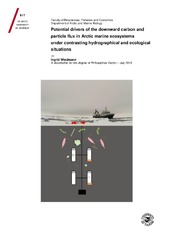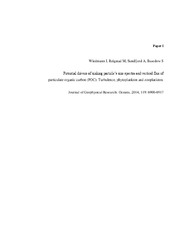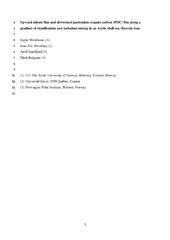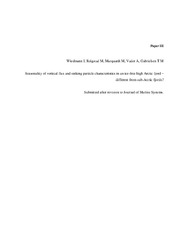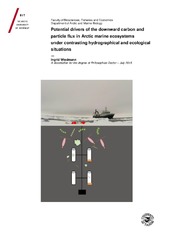| dc.contributor.advisor | Reigstad, Marit | |
| dc.contributor.author | Wiedmann, Ingrid | |
| dc.date.accessioned | 2015-12-01T15:24:22Z | |
| dc.date.available | 2015-12-01T15:24:22Z | |
| dc.date.issued | 2015-11-13 | |
| dc.description.abstract | Detailed predictions of the downward particulate organic carbon (POC) flux in a future Arctic are challenging due to the poor understanding of potential drivers. Short-term sediment traps, partly modified with gel-containing jars, were deployed in the Barents Sea (BS) and in Adventfjorden, Svalbard, to determine the downward POC flux and the particle flux (≥ 0.05 mm equivalent spherical diameter ESDimage) in a parallel manner. In this way, the quality of the sinking material could be linked to the downward POC flux and this link gave new insights into potential drivers of the carbon flux. In the Barents Sea, the highest downward POC flux (260-670 mg POC m^-2 d^-1) occurred in ice-free, deeply mixed waters. Sinking particles were < 1.00 mm ESDimage and had a high POC: volume ratio. Pulsed nitrate injections from deeper layers most likely stimulated new production, and the downward flux was enhanced by vertical mixing and “biomass repackaging” into fast-sinking pellets by zooplankton. In Adventfjorden, the highest POC flux (770-1530 mg POC m^-2 d^-1) occurred during autumn, coinciding with glacial run-off. Large, fast-sinking particles (0.05-3.62 mm ESDimage) apparently enhanced the downward POC, despite their low POC: volume ratio. In addition, entrained terrestrial POC enhanced the downward POC flux. Ballasting effects by entrained lithogenic material, flocculation and aggregate formation by pteropods are likely, but need further investigation. The present study illustrates that a high downward POC flux in Arctic marine ecosystems may occur during the phytoplankton bloom, but the highest POC downward fluxes found in the BS and Adventfjorden were found in deep-mixed waters during a post bloom situation or during an autumn situation influenced by glacial run-off, respectively. It is also shown, that a high POC downward flux may not only be caused by large particles, but also by small particles with a high POC: volume ratio. | en_US |
| dc.description.doctoraltype | ph.d. | en_US |
| dc.description.popularabstract | Havet er jordas karbonsluk, men det er usikkert hvordan effektiviteten som karbonsluk vil forandres som følge av en oppvarming av Arktis. Under feltstudier i Barentshavet og i Adventfjorden på Svalbard undersøkte jeg ved hjelp av korttidssedimentfeller hvor mye karbon som synker ut om vinteren, våren og høsten (20-200 m dybde) og hva slags partikler dette er. Analysene viste at det finnes perioder med høy karbonutsynking knyttet til våroppblomstringen, men også perioder som ikke er det. For eksempel var karbonutsynkingen veldig høy i det sørlige Barentshavet om sommeren. Mine data tyder på at vind forårsaket dyp vertikal blanding og blandet organisk material nedover i vannsøylen. I tillegg ble sakte synkende alger spist av dyreplankton og «pakket» inn i hurtig synkende avføringspellets, noe som førte til høy karbonutsynking. Et annet tilfelle av høy karbonutsynking ble observert i Adventfjorden på høsten. Denne fjorden påvirkes av isbreenes smeltevann, og dette bidro mest sannsynlig til økt karbonutsynking. | en_US |
| dc.description.sponsorship | Felt- og labarbeidet ble delvis finansiert av Arctic Field Grant (RIS 5264), Conflux prosjektet (Tromsø Forskningsstiftelse) og MicroFUN prosjekt (UNIS). | en_US |
| dc.identifier.isbn | 978-82-8266-107-2 | |
| dc.identifier.uri | https://hdl.handle.net/10037/8293 | |
| dc.identifier.urn | URN:NBN:no-uit_munin_7875 | |
| dc.language.iso | eng | en_US |
| dc.publisher | UiT The Arctic University of Norway | en_US |
| dc.publisher | UiT Norges arktiske universitet | en_US |
| dc.rights.accessRights | openAccess | |
| dc.rights.holder | Copyright 2015 The Author(s) | |
| dc.rights.uri | https://creativecommons.org/licenses/by-nc-sa/3.0 | en_US |
| dc.rights | Attribution-NonCommercial-ShareAlike 3.0 Unported (CC BY-NC-SA 3.0) | en_US |
| dc.subject | VDP::Matematikk og Naturvitenskap: 400::Zoologiske og botaniske fag: 480::Marinbiologi: 497 | en_US |
| dc.subject | VDP::Mathematics and natural science: 400::Zoology and botany: 480::Marine biology: 497 | en_US |
| dc.title | Potential drivers of the downward carbon and particle flux in Arctic marine ecosystems under contrasting hydrographical and ecological situations | en_US |
| dc.type | Doctoral thesis | en_US |
| dc.type | Doktorgradsavhandling | en_US |


 English
English norsk
norsk